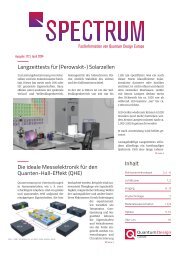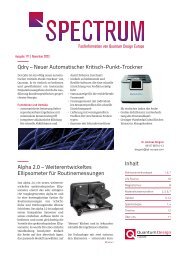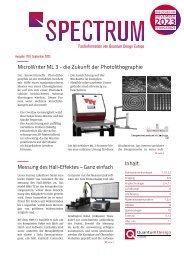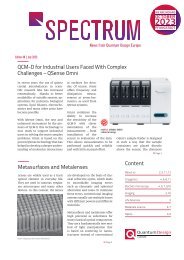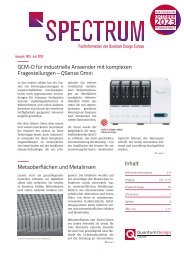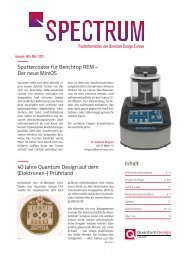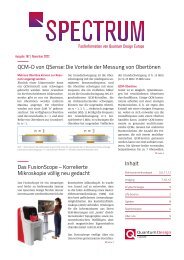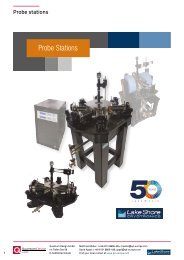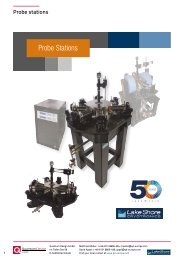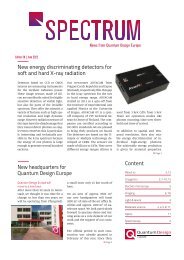Spectrum E39
You also want an ePaper? Increase the reach of your titles
YUMPU automatically turns print PDFs into web optimized ePapers that Google loves.
Materials science/About us<br />
Strain Tuning in 2D Materials – Nature<br />
Various material properties, e.g. the<br />
Curie temperature, can be influenced<br />
by stretching and compressing<br />
the materials. The Curie temperature<br />
describes the temperature above<br />
which a ferromagnetic material loses<br />
its magnetization. An easy way<br />
that does not require a mechanical<br />
test setup is inducing strain via<br />
magnetostriction or application of<br />
a voltage.<br />
Makars Šiškins of the Steeneken<br />
Team at Delft Technical University<br />
has published a spectacular paper<br />
on this topic in the journal Nature.<br />
In the paper, he describes how the<br />
resonant frequency of a 2D membrane<br />
(Cr2Ge2Te6-CGT) near its Curie<br />
temperature can be manipulated<br />
over a wide range. Embedding of a<br />
heterostructure prevents buckling<br />
and wrinkling that would normally<br />
occur in CGT membranes. The<br />
team has developed a method for<br />
studying magnetic properties almost<br />
at the level of individual layers,<br />
without interactions with the<br />
substrate distorting the measurement.<br />
Thanks to to their low mass, high<br />
strength, and resonant frequency<br />
tunability, CGT membranes are promising<br />
candidates for sensor applications<br />
and nanoelectromechanical<br />
systems.<br />
The team used a cryostation by<br />
Montana Instruments for their<br />
work. Due to its powerful vibration<br />
isolation, this special optical cryostat<br />
with closed helium loop has a<br />
vibration level of only a few nanometers<br />
in the sample chamber.<br />
Source: npj 2D Materials and Applications<br />
(2022) 6:41<br />
Please contact us<br />
materials@qd-europe.com<br />
May I introduce myself?<br />
Hello, my name is Simon Wittner<br />
and since 2017 I am responsible<br />
for the product range of sample<br />
preparation for electron microscopy<br />
such as sputter coaters and critical<br />
point dryers in the service department<br />
of Quantum Design.<br />
Before I did my apprenticeship as<br />
a physics lab technician at Quantum<br />
Design (at that time still LOT-<br />
Quantum Design), I studied physics,<br />
education and educational<br />
sciences at the University of Koblenz-Landau<br />
on a teaching degree.<br />
Outside of work, I enjoy cycling a<br />
lot with my family in the nature of<br />
the Vorderer Odenwald.<br />
My tasks at Quantum Design include<br />
maintenance and repair of the<br />
offered devices of the company<br />
Quorum, installation and training<br />
at the customer's site in Germany<br />
and abroad, telephone and email<br />
support as well as finding individual<br />
solutions for the customer.<br />
You are welcome to contact me<br />
with your questions.<br />
Please contact us<br />
wittner@qd-europe.com<br />
7 <strong>Spectrum</strong>, International edition 39| December 2022




